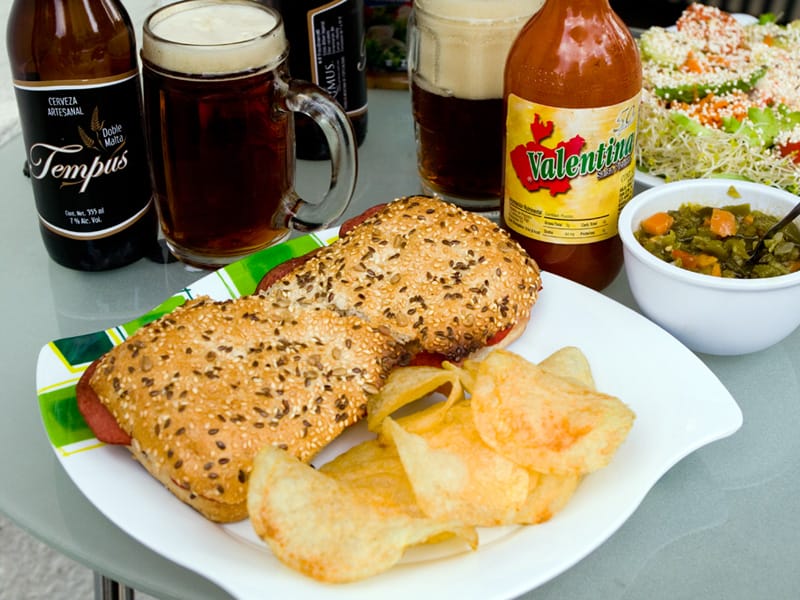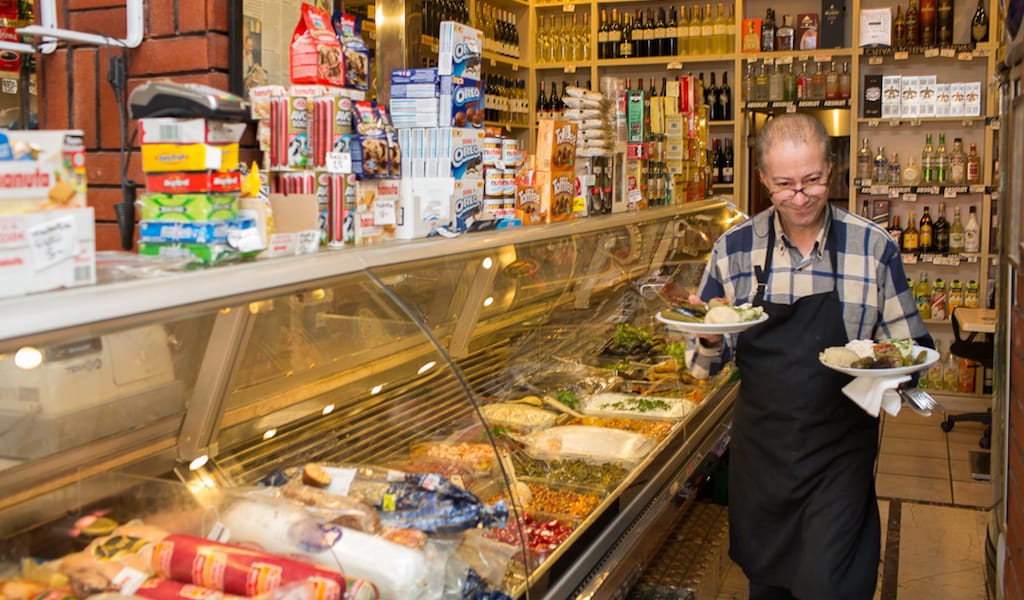Update: This spot is sadly no longer open.
A particularly eye-catching landmark in Lisbon’s Alfama district is the Casa dos Bicos (“House of the Spikes”), a 16th-century palace – once home to the Portuguese viceroy of India, and now housing the José Saramago Foundation – that has a bizarre façade of spiked stones and eclectic doors and windows. Just next to it is Reviravolta, a modest neighborhood tasca that serves up a dish with similarly iconic status: cozido a Portuguesa.
One of the most traditional Portuguese meals, cozido has humble origins; first invented in the interior Beira region, it was a dish to use up all the week’s lunch leftovers. It consists of a mixture of several kinds of meat, including chicken, pork ribs, pork belly, pig’s ear, beef shank and assorted offal, complemented by different smoked sausages: chouriço, fat and sweet paprika, blood sausage and farinheira – the latter a Jewish invention of wheat flour, paprika and pepper, nowadays mixed with pork fat. Cozido is accompanied by boiled vegetables such as beans, potatoes, cabbage, turnip greens and rice. All of that, on just one plate.
This winter dish is considered a national tradition, but there are regional variations in cooking styles; for instance, cozido das Furnas is prepared by burying a huge pot in the ground close to a geyser in the volcanic Azores Islands, the Portuguese archipelago located in the middle of the Atlantic Ocean.  Cozido is always mixed with an aromatic broth, made from its boiled meats and sometimes combined with beans and mint, bread, rice or pasta.
Cozido is always mixed with an aromatic broth, made from its boiled meats and sometimes combined with beans and mint, bread, rice or pasta.
The menu at Reviravolta (meaning “overturn” in Portuguese), which opened in the 1990s and is a stone’s throw from the river Tejo, includes regular daily specials as well as several staples with seasonal variations. Grilled scabbard or salmon with boiled green beans and potatoes, mackerel, sardines and carne alentejana – a bizarre but inspired mix of pork meat and clams – are typical dishes here. But Sunday is cozido day and for Reviravolta one of the most crowded of the week. Although the dish can be found in many downtown restaurants, Reviravolta is well known for its abundant portions and lively Sunday atmosphere that evokes the spirit of traditional Lisbon tascas.
This canteen is not a fancy place. With its paper tablecloths, hams hanging from the ceiling and the typically tiled walls, it maintains a regular base of customers; among them are employees at the nearby Finance Ministry offices, but most are workers from the increasingly numerous construction sites surrounding the nearby square. Many buildings in the area are being renovated by private investors profiting from the recent tourism boom here, but there is also speculative anticipation of the new cruise terminal that is being built at the end of the road.
Seven years ago, after working as a pub manager in London, head waiter Fernando Reis decided to come back to Lisbon because he was missing Portuguese life – and food. Nowadays, standing outside Reviravolta’s door, he watches the changes in the city with a mixture of optimism and concern. Campo das Cebolas, the nearby former 19th-century market square, now has eclectic surroundings composed of docklands and historical residential buildings. The palm tree-lined square itself, once a thriving public space that is now a popular parking spot, is currently undergoing renovation, with more and more tourists wandering past, especially around lunchtime.
The palm tree-lined square itself, once a thriving public space that is now a popular parking spot, is currently undergoing renovation, with more and more tourists wandering past, especially around lunchtime.
“When the new terminal is finished [at the end of 2016], an enormous flow of tourists will cross this area, and everything will change,” says Fernando. The project has been contested by local residents, who are concerned about its consequences for social sustainability and the neighborhood’s heritage.
Despite this ambiguous view of the future, Fernando is certain that Reviravolta will keep its authenticity intact. And, unlike at other restaurants in the square, there is no intention of increasing prices: The bill for a plentiful portion of cozido and a glass of house wine is still just €6.50.
 December 7, 2012 La Vaca de Muchos Colores
December 7, 2012 La Vaca de Muchos Colores
In Mexico, sandwiches generally come in the form of the torta, usually made out of a […] Posted in Mexico City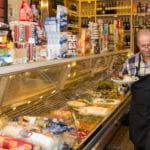 October 19, 2017 Tadal’s Topik
October 19, 2017 Tadal’s Topik
On a late spring afternoon I sat at the only table at Tadal, an Armenian deli in […] Posted in Istanbul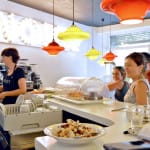 September 17, 2015 Norte
September 17, 2015 Norte
On a beautiful corner of L’Eixample sits Norte, a small yet warm, inviting and […] Posted in Barcelona
Published on January 29, 2016
Related stories
December 7, 2012
Mexico CityIn Mexico, sandwiches generally come in the form of the torta, usually made out of a white bread roll known as a bolillo that has been sliced in half and then filled to the brim with meat, avocado, tomato, onion and sliced jalapeño peppers. In Mexico City’s San Rafael neighborhood, however, a family-owned sandwich shop called…
October 19, 2017
Istanbul | By Robyn Eckhardt
IstanbulOn a late spring afternoon I sat at the only table at Tadal, an Armenian deli in Kurtuluş. Behind me were shelves lined with imported liquors: French, Greek and Georgian wines, Russian vodkas, an admirable range of Scotch whiskies. Opposite, a refrigerated case groaned with mezes (lakerda and taramasalata, rice-filled sweet red pepper dolma and…
September 17, 2015
BarcelonaOn a beautiful corner of L’Eixample sits Norte, a small yet warm, inviting and light-filled bar with a constellation of shining lights spelling out its name inside and a few tables with fresh flowers. The restaurant was started by three partners, Lara Zaballa, María González and Fernando Martínez-Conde (who left the project last year). They…







































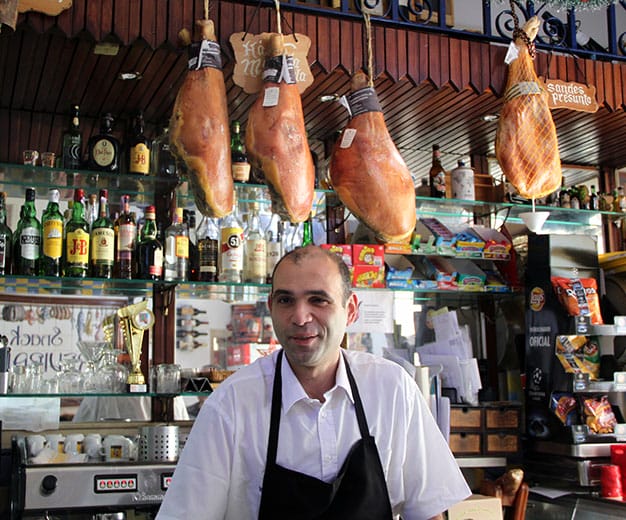
 Cozido is always mixed with an aromatic broth, made from its boiled meats and sometimes combined with beans and mint, bread, rice or pasta.
Cozido is always mixed with an aromatic broth, made from its boiled meats and sometimes combined with beans and mint, bread, rice or pasta. The palm tree-lined square itself, once a thriving public space that is now a popular parking spot, is currently undergoing renovation, with more and more tourists wandering past, especially around lunchtime.
The palm tree-lined square itself, once a thriving public space that is now a popular parking spot, is currently undergoing renovation, with more and more tourists wandering past, especially around lunchtime.


